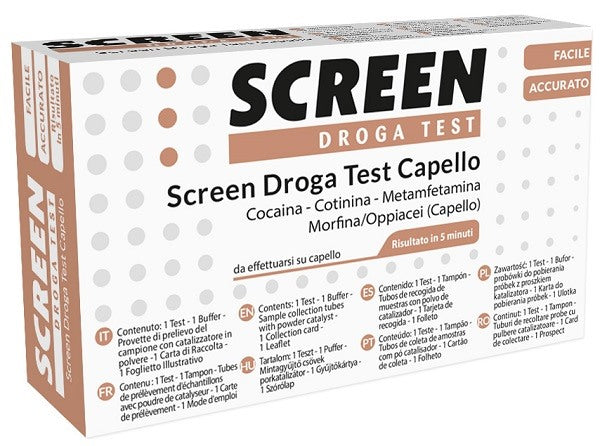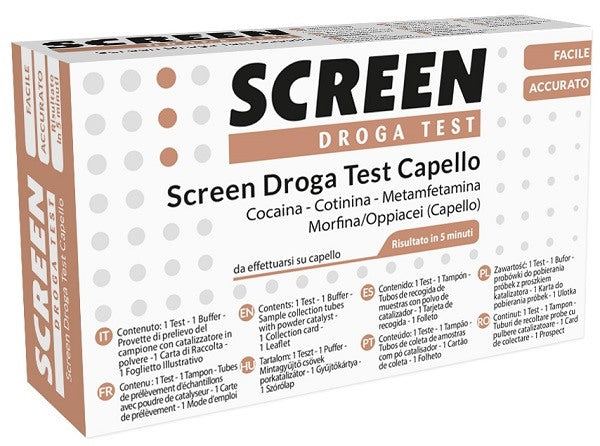SCREEN DRUG TEST 4 SUBSTANCES THROUGH HAIR DRUG TEST HAIR SCREEN ITALY
Sold out
41% off
€14,26
€24,00
Unit price
/
Unavailable
Tax included, shipping and discounts calculated at checkout.
Screen Italia | SKU:
927972303
Notify me when it's back in stock!
Write us your email, you will be notified when this product becomes available again!
SCREEN DRUG TEST 4 SUBSTANCES THROUGH HAIR DRUG TEST HAIR SCREEN ITALY is backordered and will ship as soon as it is back in stock.
Shipping Costs and Times
Shipping Costs and Times
- Order fulfillment within 24 hours and delivery within the following 48/72 hours.
- Shipping cost: always free for orders over €49.90, otherwise it costs €4.99.
Payments
Payments
Payment information is processed securely. We do not store credit card information or have access to your credit card information.
Returns and Refunds
Returns and Refunds
You can return and receive a refund for the item within 30 days. See full policy here.

Do you need help?
Our customer service is here to help you!
- Contact us by phone, email or WhatsApp, from Monday to Friday, from 9:00 to 20:00 .
- For common questions, such as tracking your order or checking its fulfillment status, you can count on our artificial intelligence , available 24/7 .
We are always at your side to offer you fast and effective support!
Description
Description
SCREEN DRUG TEST 4 SUBSTANCES THROUGH HAIR DRUG TEST HAIR SCREEN ITALY
SCREEN
DRUG TEST
Description
Instructions for use for each combination test for the following drugs: Cotinine, Methamphetamine, Morphine/Opiates and Cocaine. One-step test for the simultaneous qualitative detection of drugs of abuse in human hair.
During the test, the lysate breaks down keratin, the main component of hair, and releases the drug molecules to be tested. The hair lysate migrates by capillary action.
A drug, if present in the hair lysate below its cutoff concentration, will not saturate the binding sites of its specific antibody. The antibody will then react with the drug-protein conjugate and a visible colored line will appear in the test region of the drug-specific dipstick. The presence of drug above the cutoff concentration will saturate all binding sites of the antibody. Therefore, the colored line will not appear in the test region. A drug-positive hair lysate sample will not generate a colored line in the drug-specific test region of the dipstick due to competition with the drug, while a drug-negative hair sample will generate a line in the test region due to the absence of competition with the drug. As a procedural control, a colored line will always appear in the control region, indicating that an adequate volume of sample has been added and membrane wicking has occurred.
How to use
Allow the test, specimen, swab and/or controls to reach room temperature.
1. Collect the hair sample from the hair length close to the skin and cut the hair no more than 3 cm long and no less than 100 mg. Cut the collected hair into small pieces.
2. Add the swab to the sample collection tube with catalyst powder and shake well.
3. Add the hair sample to the preparation, tighten the cap on the sample collection tube and shake the tube vigorously. Leave the tube for 5 minutes.
4. Remove the test cassette from the sealed pouch and use it within one hour. Place the test cassette on a clean, flat surface. Open the cap of the sample collection tube and transfer 3 full drops of sample into the sample well (S) of the test cassette, then start the timer. Avoid trapping air bubbles in the sample well (S).
5. Wait for the colored lines to appear. Read the results after 5 minutes. Do not interpret the result after 10 minutes (see illustration below).
Interpretation of results
NEGATIVE:* A colored line appears in the control region (C) and a colored line appears in the test regions (T). This negative result means that the concentrations of the target analyte (COT, MET, MOP and COC) in the hair are below the designated cut-off levels for the target analyte.
*NOTE: The shade of the colored lines in the test region (T) may vary. The result should be considered negative whenever even a faint line is present.
POSITIVE: A colored line appears in the control region (C) and no line appears in the test region (T). A positive result means that the concentration of the target analyte (COT, MET, MOP, and COC) in the hair sample is above the designated cut-off for the target analyte.
INVALID: No line appears in the control region (C). Insufficient specimen volume or incorrect procedural techniques are the most likely reasons for control line failure. Reread the directions and repeat the test with a new test. If the result is still invalid, contact the manufacturer.
Warnings
- Not for medical or diagnostic use.
- Do not use after the expiry date.
- The test device must remain sealed until ready for use.
- All samples must be considered potentially hazardous and, therefore, must be handled with the precautions expected for potentially infectious products.
- Used test materials must be disposed of in accordance with local regulations.
The kit should be stored at 2-30°C in its sealed pouch. The catalyst powder can be stored at 2-30°C for up to 18 months prior to testing. However, these are enzyme reagents that work best when stored at 2-8°C. Therefore, although the kit is stable up to 30°C, it is recommended that it be stored at 2-8°C to improve the performance of the catalyst powder. The test strip device is stable until the expiration date printed on the pouch label. The test strip device should be stored in its sealed pouch until use. Do not freeze. Do not use after the expiration date.
The Multi-Drug Rapid Test Cassette (Hair) provides only a qualitative and preliminary analytical result. To obtain a confirmed result, a secondary analytical method must be used. Gas chromatography/mass spectrophotometry (GC/MS) is the preferred confirmatory method.
2. It is possible that technical or procedural errors, as well as other interfering substances in the hair sample, may cause erroneous results.
3. Adulterants, such as bleach, in hair samples may produce erroneous results regardless of the analytical method used. If adulteration is suspected, the test should be repeated with another hair sample.
4. A positive result indicates the presence of the drug or its metabolites, but does not indicate the level of intoxication, the route of administration, or the concentration in the hair.
5. A negative result does not necessarily indicate a drug-free hair. Negative results may be obtained when the drug is present but below the cut-off level of the test.
6. The test does not distinguish between drugs of abuse and some medications.
Code DOA-H945
Instructions for use for each combination test for the following drugs: Cotinine, Methamphetamine, Morphine/Opiates and Cocaine. One-step test for the simultaneous qualitative detection of drugs of abuse in human hair.
During the test, the lysate breaks down keratin, the main component of hair, and releases the drug molecules to be tested. The hair lysate migrates by capillary action.
A drug, if present in the hair lysate below its cutoff concentration, will not saturate the binding sites of its specific antibody. The antibody will then react with the drug-protein conjugate and a visible colored line will appear in the test region of the drug-specific dipstick. The presence of drug above the cutoff concentration will saturate all binding sites of the antibody. Therefore, the colored line will not appear in the test region. A drug-positive hair lysate sample will not generate a colored line in the drug-specific test region of the dipstick due to competition with the drug, while a drug-negative hair sample will generate a line in the test region due to the absence of competition with the drug. As a procedural control, a colored line will always appear in the control region, indicating that an adequate volume of sample has been added and membrane wicking has occurred.
How to use
Allow the test, specimen, swab and/or controls to reach room temperature.
1. Collect the hair sample from the hair length close to the skin and cut the hair no more than 3 cm long and no less than 100 mg. Cut the collected hair into small pieces.
2. Add the swab to the sample collection tube with catalyst powder and shake well.
3. Add the hair sample to the preparation, tighten the cap on the sample collection tube and shake the tube vigorously. Leave the tube for 5 minutes.
4. Remove the test cassette from the sealed pouch and use it within one hour. Place the test cassette on a clean, flat surface. Open the cap of the sample collection tube and transfer 3 full drops of sample into the sample well (S) of the test cassette, then start the timer. Avoid trapping air bubbles in the sample well (S).
5. Wait for the colored lines to appear. Read the results after 5 minutes. Do not interpret the result after 10 minutes (see illustration below).
Interpretation of results
NEGATIVE:* A colored line appears in the control region (C) and a colored line appears in the test regions (T). This negative result means that the concentrations of the target analyte (COT, MET, MOP and COC) in the hair are below the designated cut-off levels for the target analyte.
*NOTE: The shade of the colored lines in the test region (T) may vary. The result should be considered negative whenever even a faint line is present.
POSITIVE: A colored line appears in the control region (C) and no line appears in the test region (T). A positive result means that the concentration of the target analyte (COT, MET, MOP, and COC) in the hair sample is above the designated cut-off for the target analyte.
INVALID: No line appears in the control region (C). Insufficient specimen volume or incorrect procedural techniques are the most likely reasons for control line failure. Reread the directions and repeat the test with a new test. If the result is still invalid, contact the manufacturer.
Warnings
- Not for medical or diagnostic use.
- Do not use after the expiry date.
- The test device must remain sealed until ready for use.
- All samples must be considered potentially hazardous and, therefore, must be handled with the precautions expected for potentially infectious products.
- Used test materials must be disposed of in accordance with local regulations.
The kit should be stored at 2-30°C in its sealed pouch. The catalyst powder can be stored at 2-30°C for up to 18 months prior to testing. However, these are enzyme reagents that work best when stored at 2-8°C. Therefore, although the kit is stable up to 30°C, it is recommended that it be stored at 2-8°C to improve the performance of the catalyst powder. The test strip device is stable until the expiration date printed on the pouch label. The test strip device should be stored in its sealed pouch until use. Do not freeze. Do not use after the expiration date.
The Multi-Drug Rapid Test Cassette (Hair) provides only a qualitative and preliminary analytical result. To obtain a confirmed result, a secondary analytical method must be used. Gas chromatography/mass spectrophotometry (GC/MS) is the preferred confirmatory method.
2. It is possible that technical or procedural errors, as well as other interfering substances in the hair sample, may cause erroneous results.
3. Adulterants, such as bleach, in hair samples may produce erroneous results regardless of the analytical method used. If adulteration is suspected, the test should be repeated with another hair sample.
4. A positive result indicates the presence of the drug or its metabolites, but does not indicate the level of intoxication, the route of administration, or the concentration in the hair.
5. A negative result does not necessarily indicate a drug-free hair. Negative results may be obtained when the drug is present but below the cut-off level of the test.
6. The test does not distinguish between drugs of abuse and some medications.
Code DOA-H945


